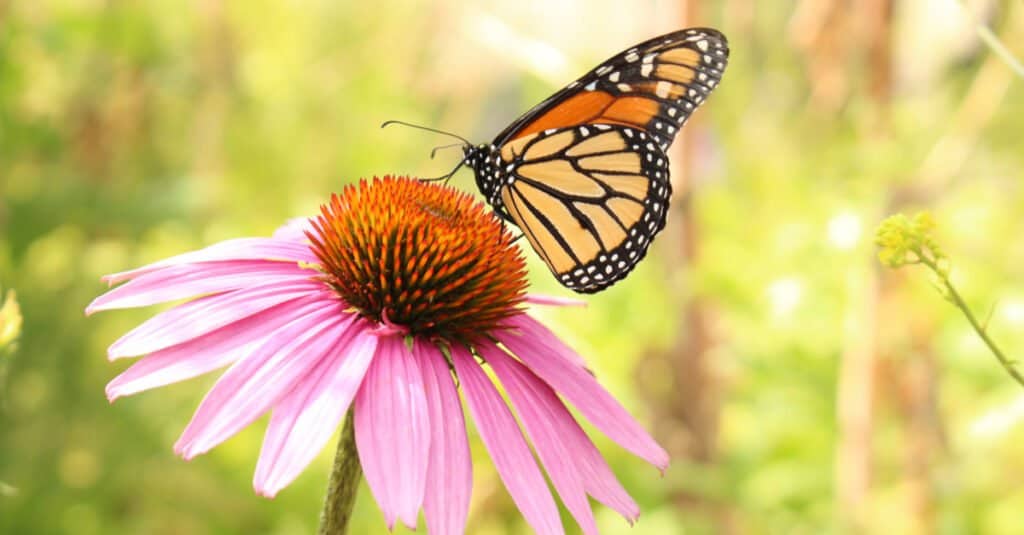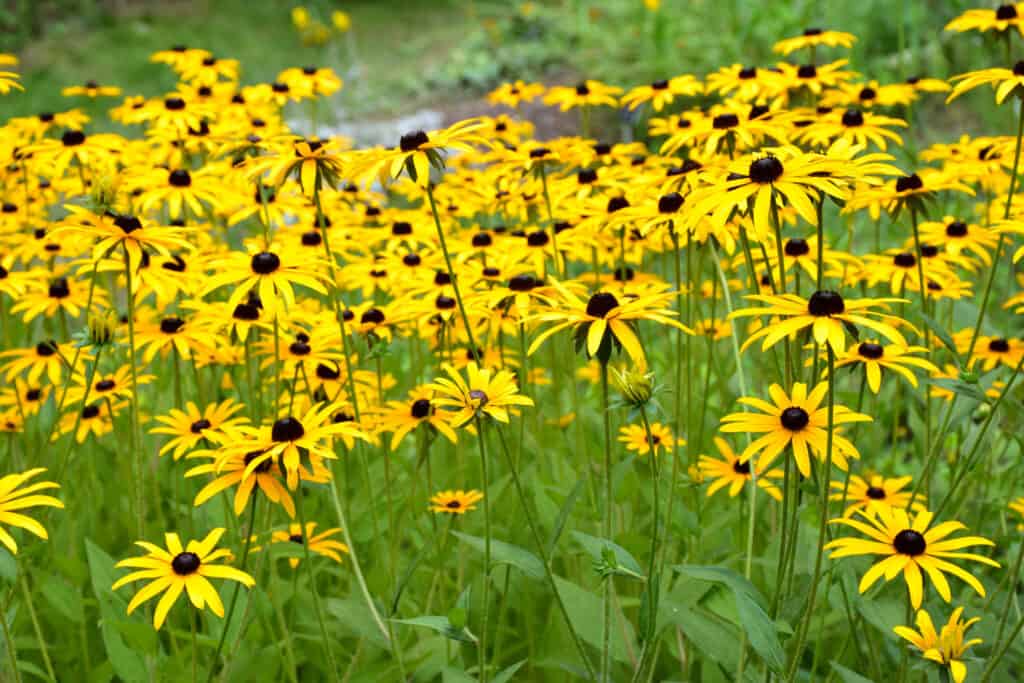Black-eyed Susan and coneflower are two very similar plants. If you were to find them in the wild, you probably couldn’t tell them apart. This is the exact reason we’re here – to tell you the main characteristics of each plant and highlight their differences.
However, before we start, it’s worth mentioning that the term “coneflower” refers, in fact, to five different genera – Dracopis, Echinacea, Rudbeckia, Ratibida, and Isopogon, each consisting of many species. Since it would be impossible to compare black-eyed Susan with a multitude of species from five genera, we’ve decided to focus only on Echinacea, whose species are some of the most popular among plant enthusiasts.
This genus consists of ten different species. All species are called coneflowers, and one of their main differences is the color of their petals (as you’ll see below).
Without any further ado, let’s take a look at black-eyed Susan vs. coneflower!
Comparing Black-Eyed Susan vs. Coneflower
| Black-Eyed Susan | Coneflower | |
|---|---|---|
| Family | Asteraceae | Asteraceae |
| Genus | Rudbeckia | Echinacea |
| Scientific name | Rudbeckia hirta | – |
| Native to | Central and eastern North America | Central and eastern North America |
| Preferred soil type | Sand, loam, and clay | Sand, loam, and clay |
| Preferred moisture level | Dry and moist, medium levels | Dry, medium levels |
| Average height | 1 to 3 feet | 3 to 4 feet |
| Blooming time | June, July, August, and September | Varied depending on species, usually during spring, summer, or autumn |
| Bloom color | Yellow | Varied, depending on the species |
| Type of root | Fibrous | Fibrous |
| Benefits in the garden | Attracts pollinators and birds | Attracts pollinators and birds |
| Sowing time | Spring, early summer, and fall | Spring, early summer, and fall |
What Is a Black-Eyed Susan?

Black-eyed Susan is a flowering plant native to central and eastern North America.
©iStock.com/Mariia Romanyk
Black-eyed Susan is a flowering plant native to central and eastern North America. It is scientifically named Rudbeckia hirta and is part of the Rudbeckia genus in the Asteraceae family. Nowadays, the flower can be found in all 48 states of the contiguous United States and all 10 Canadian provinces. In short, it is a common flower, and it is also Maryland’s state flower.
There are four varieties of black-eyed Susan, each appearing in different regions. Angustifolia appears in the south-central and southeastern U.S.; floridana in Florida; hirta in the eastern U.S.; and pulcherrima throughout North America.
What Is a Coneflower?

Coneflowers are represented by ten species native to central and eastern North America.
©RukiMedia/Shutterstock.com
As we’ve already established, this article will only refer to the coneflowers in the Echinacea genus in the Asteraceae family.
These coneflowers are represented by ten species native to central and eastern North America. The ten species are usually named after their petal color (purpurea, sanguinea) or by a descriptive term (tennesseensis, serotina, simulata).
Leaving Echinacea aside, the most interesting thing is that the term “coneflower” is also used in regard to some species in the Rudbeckia genus, which black-eyed Susan is part of, too. Can you see now how intertwined things are with these two terms? That’s why we’ve chosen another genus to compare black-eyed Susans to!
The Key Differences Between Black-Eyed Susan vs. Coneflower
The two species – or better said, types of flowers – are very similar in appearance. On top of that, the fact that they are native to the same regions doesn’t help either. As such, in the following lines, we’ll showcase several key differences between coneflower and black-eyed Susan.
Black-Eyed Susan vs. Coneflower: Classification and Type

The black-eyed Susan is an annual, upright-growing flowering plant.
©Irena Socratous/Shutterstock.com
The black-eyed Susan is an annual, upright-growing flowering plant. However, it can sometimes be perennial or biennial. It is part of the Rudbeckia genus, known for a raised central disc of various colors on the flowerhead. This disc is the reason why the plant is named black-eyed Susan. On top of that, the same disc led to another name being given to plants in the Rudbeckia genus – namely, coneflowers. So basically, the Rudbeckia genus consists of both black-eyed Susans and coneflower species.
Now you can see why comparing the two is essential for plant enthusiasts!
Coneflowers (those in the Echinacea genus) are herbaceous perennial plants. They are known to tolerate drought conditions, and almost all of them grow from taproots. While black-eyed Susans have a prominent central disc, coneflowers in the Echinacea genus are characterized by hemispheric involucres – the center of the flowerhead.
It is worth mentioning that both flowers are part of the Asteraceae family. Plants in this family are often referred to as sunflowers and daisies. This is yet another reason for the many similarities between black-eyed Susan and coneflower.
Black-Eyed Susan vs. Coneflower: Appearance
Black-eyed Susan grows up to about 39 inches tall and about 18 inches wide. Its leaves are basal and can grow up to 7 inches long. The flowerhead is composite and daisy-like; it appears in early autumn (sometimes late summer) and is usually about 4 inches in diameter. It features vibrant yellow florets and a dark center. The number of similarities with coneflowers grows further, as black-eyed Susans can nowadays appear in a variety of colors and sizes due to extensive breeding.
The species in the Echinacea genus usually grow up to 4 feet high. Like black-eyed Susans, they grow from taproots (except for Echinacea purpurea). The flowers are located at the end of the plant’s long peduncles. The paleae are longer than disc corollas, and their ends vary in color; they can be anything from orange to reddish purple. The petals are brightly colored. Depending on the species, they can be pink, purple, yellow, or white, among other colors.
Black-Eyed Susan vs. Coneflower: Cultivation

Coneflowers are a perfect choice for small gardens.
©iStock.com/Jasmina81
Black-eyed Susan is reportedly easy to grow and is often preferred by enthusiasts thanks to its prolonged bloom time. While in bloom, it will attract pollinators and butterflies. Birds, especially finches, are attracted to the plant’s seed heads.
You might want to pick up cultivating black-eyed Susans in your garden as the flower tolerates drought, heat, and various soils. All you have to remember is that it doesn’t perform well in wet soils that are poorly drained.
Coneflowers are a perfect choice for small gardens. Even if most species are in bloom only during summer, their wide color range will be enough to make you happy! Coneflowers prefer a decent amount of sun and specific soil conditions. Most species enjoy fertile loam but won’t give up on growing in clay or even drier soil. It can be considered a drought-resistant plant but might not reach its full potential if exposed to dry soil for too long.
Black-Eyed Susan vs. Coneflower: Uses
Black-eyed Susan is commonly used to attract butterflies and enhance the garden landscape. It has been historically used by Native American people as a herbal medicine; it is believed to treat flu and infections. The flower was also used as a poultice against snake bites. Nowadays, some people use black-eyed Susan root tea to treat worms and colds.
Thanks to their many health benefits, certain coneflower species are nowadays used in herbal teas and various supplements because they feature immuno-stimulant activity. However, due to several studies on the effects of coneflower plants, using Echinacea-based products is generally not recommended. Even more, the United States Food and Drug Administration stated that the species in the Echinacea genus aren’t safe or effective and shouldn’t be used for any health purposes.
Bonus: What Do Black-Eyed Susans and Coneflowers Symbolize?

Black-eyed Susans are symbols of encouragement and justice.
©LauraTabor/iStock via Getty Images
Black-eyed Susans are usually yellow – and yellow flowers are symbols of happiness and joy. The color yellow is also symbolic of positive change and motivation – and black-eyed Susans often represent justice. These sunny yellow beauties also have ties to childhood and the innocent joys of having an active imagination and a sense of awe for the wonders of nature. These qualities led the state of Maryland to name a prominent award – The Black-Eyed Susan Award – a student choice literary award given to promote book fandom and literacy – after the flower.
Because of their use for medicinal purposes, coneflowers represent health, strength, and healing. A bouquet of coneflowers is an appropriate gift for someone who is sick to help them to feel better. They can brighten an ailing friend’s day and offer hope for renewed health and strength.
The photo featured at the top of this post is ©
Sources
- Wildflower Center, Available here: https://www.wildflower.org/plants/result.php?id_plant=ruhi2
- Wildflower Center, Available here: https://www.wildflower.org/plants/result.php?id_plant=ecpu
- Prairie Nursery, Available here: https://www.prairienursery.com/black-eyed-susan-rudbeckia-hirta.html
- Prairie Nursery, Available here: https://www.prairienursery.com/purple-coneflower-echinacea-purpurea.html
Thank you for reading! Have some feedback for us? Contact the AZ Animals editorial team.






